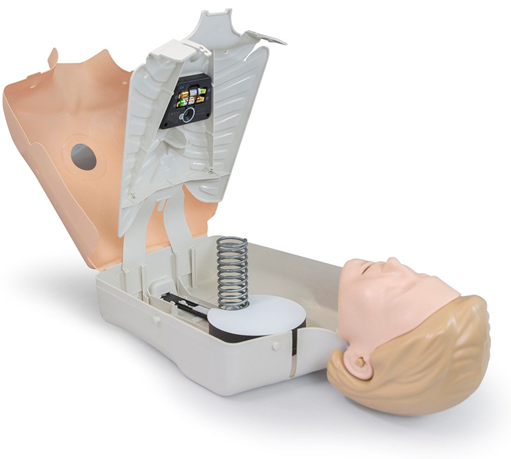


Little Anne and Little Junior QCPR include a hardware module with a QCPR Sensor to measure compressions and ventilations.
The QCPR Sensor is an integrated electronic device mounted under the rib plate that registers compressions and ventilations. It communicates QCPR feedback wirelessly to external devices via Bluetooth or wired via the SkillGuide (I2C).
The manikin connects to the QCPR Apps via Bluetooth and to SkillGuide via a 2,5mm audio jack connector.
Illustrations for Little Anne and Little Junior QCPR
Compressions are measured by an infrared proximity sensor, which measures the distance from the chest plate to the back section. The sensor sends infrared light to the reflector and analyzes the distance based on the intensity of the light returning from the reflector. Ventilations are measured by an inductive sensor, which measures how much the chest rises when the manikin is ventilated. The manikin’s lungs expand and press the chest plate downwards and the chest upwards. The sensor measures the change in induction and translates that into feedback on chest rise.
Inductive sensor (ventilation)
An inductive coil PCB is mounted close to the inside of the Rib plate. A sheet metal disc is glued to the inside of the Chest skin.
When the lung is expanded, the Chest skin and sheet metal are lifted from the Rib plate, causing a change in the electromagnetic field that is picked up by an inductive sensor through the coil PCB.
IR sensor (compressions)
A sensor on the back of the Rib plate emits Infrared light to a reflective surface in the Back section. The intensity of the reflected light is used to determine the distance from the sensor to the reflective surface.
Ventilation measurement
Ventilating the manikin will raise the chest skin relative to the Rib plate and compress the rib plate towards the Back section. Due to this, the ventilations are measured using both sensors. The lung expansion, in combination with the compression of the chest, is used to calculate an approximate value in ml for inflated lung volume.
Compression measurement
Compressing the chest will decrease the distance between the Rib plate and the Back section, which is measured by the IR distance sensor and used to calculate the compression value in mm.
ON/OFF
The QCPR Sensor does not have an ON/OFF button. It is either in “standby” mode or “ON”.
| ON Condition | QCPR Sensor automatically wakes up from standby mode when the user compresses the chest (deeper than 20 mm for a duration of > 250 milliseconds) |
| OFF Condition |
Connected to an external device via the After 5 minutes, the sensor automatically goes into standby mode.2) If more than 30 compressions are performed, the QCPR Sensor enters summative feedback mode after 30 seconds of compression inactivity. After 45 seconds in summative feedback mode, the QCPR sensor enters standby mode. |
Power status
| STANDBY | All systems are shut down except for the IR sensor, which checks for movement of the chest every 125 ms. |
| ON | The system is on and connectable. System operations will be described in the “CPR Session” section below. |
Selftest
When entering the ON state, the QCPR sensor shall perform a self-test to verify that the compression and ventilation sensors are functional. An audible beep will indicate that the self-test has passed. If it has not, the sensor will shut down.
Indicators
| Sound – One beep | Unit is ON | The unit has woken up from standby mode |
| Blue LED – Blinking | Ready to connect | The unit is available and prepared to establish a Bluetooth (BLE) connection. |
| Blue LED – Steady on | Connected | The unit has established a BLE connection with a mobile Device |